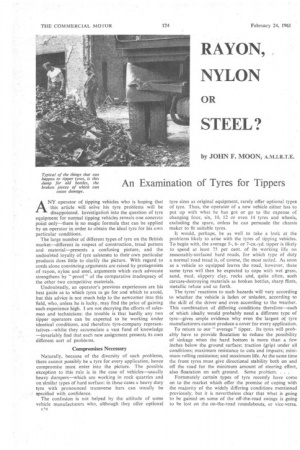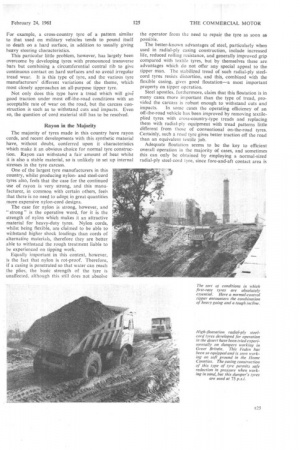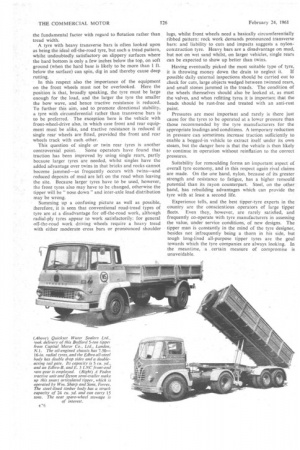RAYON, NYLON
Page 90

Page 91

Page 92

If you've noticed an error in this article please click here to report it so we can fix it.
OR
• STEEL?
by JOHN F. MOON, A.M.I.R.T.E.
An Examination of Tyres for Tippers
NY operator of tipping vehicles who is hoping that this article wilt solve his tyre problems will be disappointed. Investigation into the question of tyre equipment for normal tipping vehicles reveals one concrete point only—there is no magic formula that can be applied by an operator in order to obtain the ideal tyre for his own particular conditions.
The large number of different types of tyre on the British market—different in respect of construction, tread pattern and material—presents a confusing picture, and the undoubted loyalty, of tyre salesmen to their own particular products does little to clarify the picture. With regard to cords alone convincing arguments are raised by protagonists of rayon, nylon and steel, arguments which each advocate strengthens by " proof " of the comparative inadequacy of the other two competitive materials.
Undoubtedly, an operator's previous experiences are his best guide as to which tyres to go for and which to avoid, but this advice is not much help to the newcomer into this field, Who, unless he is lucky, may find the price of gaining such experience high. I am not decrying the efforts of salesmen and technicians: the trouble is that hardly any two tipper operators can be expected to be working under identical conditions, and therefore tyre-company representatives—whilst they accumulate a vast fund of knowledge —invariably find that each new assignment presents its own different sort of problems.
Compromises Necessary
Naturally, because of the diversity of such problems, there cannot possibly be a tyre for every application, hence compromise must enter into the picture. The possible exception to this rule is in the case of vehicles—usually heavy dumpers—which are working in rock quarries and on similar types of hard surface: in these cases a heavy duty tyre with pronounced transverse bars can usually be specified with confidence.
The confusion is not helped by the attitude of some vehicle manufacturers who, although they offer optional E,4
tyre sizes as original equipment, rarely offer optional types of tyre. Thus, the operator of a new vehicle either has to put up with what he has got or go to the expense of changing four, six, 10, 12 or even 14 tyres and wheels, excluding the spare, unless he can persuade the chassis maker to fit suitable tyres.
It would, perhaps, be as well to take a look at the problems likely to arise with the tyres of tipping vehicles. To begin with, the average 5-, 6or 7-cu.-yd tipper is likely to spend at least 75 per cent. of its working life on reasonably-surfaced hard roads, for which type of duty a normal road tread is, of course, the most suited. As soon as a vehicle so equipped leaves the road, however, these same tyres will then be expected to cope with wet grass, sand, mud, slippery clay, rocks and, quite often, such carcase-destroying materials as broken bottles, sharp flints, metallic refuse and so forth.
The tyres' reactions to such hazards will vary according to whether the vehicle is laden or unladen, according to the skill of the driver and even according to the weather. This combination of differing conditions therefore—each of which ideally would probably need a different type of tyre—gives ample evidence why even the largest of tyre manufacturers cannot produce a cover for every application.
To return to our "average" tipper. Its tyres will probably have to provide floatation to reduce the possibility of sinkage when the hard bottom is more than a few inches below the ground surface; traction (grip) under all conditions; maximum resistance to cuts and impacts; minimum rolling resistance; and maximum life. At the same time the front tyres must give directional stability both on and off the road for the minimum amount of steering effort, also floatation on soft ground. Some problem. . .
Fortunately certain types of tyre recently have come on to the market which offer the promise of coping with the majority of the widely differing conditions mentioned previously, but it is nevertheless clear that what is going to be gained on some of the off-the-road swings is going to be lost on the on-the-road roundabouts, or vice-versa. For example, a cross-country tyre of a pattern similar to that used on military vehicles tends to pound itself to death on a hard surface, in addition to usually giving heavy steering characteristics.
This particular little problem, however, has largely been overcome by developing tyres with pronounced transverse bars but combining a circumferential central rib to give continuous contact on hard surfaces and so avoid irregular tread wear. It is this type of tyre, and the various tyre manufacturers' different variations of the theme, which most closely approaches an all-purpose tipper tyre.
Not only does this type have a tread which will give good traction under most off-the-road conditions with an acceptable rate of wear on the road, but the carcass construction is such as to withstand cuts and impacts. Even so, the question of cord material still has to be resolved.
Rayon in the Majority The majority of tyres made in this country have rayon cords, and recent developments with this synthetic material have, without doubt, conferred upon it characteristics which make it an obvious choice for normal tyre construction. Rayon can withstand a fair amount of heat whilst it is also a stable material, so is unlikely to set up internal stresses in the tyre carcass.
One of the largest tyre manufacturers in this country, whilst producing nylonand steel-cord tyres also, feels that the case for the continued use of rayon is very strong, and this manufacturer, in common with certain others, feels that there is no need to adopt in great quantities more expensive nylon-cord designs.
The case for nylon is strong, however, and " strong " is the operative word, for it is the strength of nylon which makes it an attractive material for heavy-duty tyres. Nylon cords, whilst being flexible, are claimed to be able to withstand higher shock loadings than cords of alternative materials, therefore they are better able to withstand the rough treatment liable to be experienced on tipping work.
Equally important in this context, however, is the fact that nylon is rot-proof. Therefore, if a casing is penetrated so that water can reach• the plies, the basic strength of the tyre is unaffected, although this still does not absolve the operator from the need to repair the tyre as soon as possible.
The better-known advantages of steel, particularly when used in radial-ply casing construction, include increased life, reduced rolling resistance, and generally improved grip compared with textile tyres, but by themselves these are advantages which do not offer any special appeal to the tipper man. The stabilized tread of such radial-ply steelcord tyres resists distortion, and this, combined with the flexible casing, gives good floatation—a most important property on tipper operation.
Steel apostles, furthermore, claim that this floatation is in many cases more important than the type of tread, provided the carcass is robust enough to withstand cots and
impacts. In some cases the operating efficiency of an off-the-road vehicle has been improved by removing textileplied tyres with cross-country-type treads and replacing them with radial-ply equipment with tread patterns little different from those of conventional on-the-road tyres. Certainly, such a road tyre gives better traction off the road than an equivalent textile job.
Adequate floatation seems to he the key to efficient overall operation in the majority of eases, and sometimes this can only be obtained by employing a normal-sized radial-ply steel-cord tyre, since fore-and-aft contact area is the fundamental factor with regard to flotation rather than tread width..
A tyre with heavy transverse bars is often looked upon as being the ideal off-the-road tyre, but such a tread pattern, whilst undoubtedly satisfactory on slippery surfaces where the hard bottom is only a few inches below the top, on soft ground (when the hard base is likely to be more than 1 ft. below the surface) can spin, dig in and thereby cause deep rutting.
In this respect also the •.importance of the equipment on the front wheels must not be overlooked. Here the position is that, broadly speaking, the tyre must be large enough for the load, and the larger the tyre the smaller the bow wave, and hence tractive resistance is reduced. To further this aim, and to promote directional stability, a tyre with circumferential rather than transverse bars is to be preferred. The exception here is the vehicle with front-wheel-drive also, in which case front and rear equipment must be alike, and tractive resistance is reduced if single rear wheels are fitted, provided the front and rear wheels track with each other.
This question of single or twin rear tyres is another controversial point. Some operators have found that traction has been improved by using single rears, partly because larger tyres are needed, whilst singles have the added advantage over twins in that bricks and rocks cannot become jammed—as frequently occurs with twins—and reduced deposits of mud are left on the road when leaving the site. Because larger tyres have to be used, however, the front tyres also may have to be changed, otherwise the tipper will be "nose down "and inter-axle load distribution may be wrong.
Summing up a confusing picture as well as possible, therefore, it is seen that conventional road-tread types of tyre are at a disadvantage for off-the-road work, although radial-ply tyres appear to work satisfactorily: for general off-the-road work driving wheels require a heavy tread with -either moderate cross bars or pronounced shoulder
lugs, whilst front wheels need a basically circumferentially ribbed pattern: rock work demands pronounced transverse bars: and liability to cuts and impacts suggests a nylonconstruction tyre. Heavy bars are a disadvantage on mud, but not on wet sand whilst, on larger vehicles, single rears can be expected to show up better than twins.
Hiving eventually picked the most suitable type of tyre, it is throwing money down the drain to neglect it. If possible daily external inspections should be carried out to check for cuts, large objects wedged between twinned rears, and small stones jammed in the treads. The condition of the wheels themselves should also be looked at, as must the valves, and when refitting tyres it is important that the beads should be rust-free and treated with an anti-rust paint.
Pressures are most important and rarely is there just cause for the tyres to be operated at a lower pressure than those recommended by the tyre manufacturers for the appropriate loadings and conditions. A temporary reduction in pressure can sometimes increase traction sufficiently to enable a bogged-in vehicle to extract itself under its own steam, but the danger here is that the vehicle is then likely to continue in operation without reinflat ion to the correct pressures.
Suitability for remoulding forms an important aspect of overall tyre economy, and in this respect again rival claims are made. On the one hand, nylon, because of its greater strength and resistance to fatigue, has a higher remould potential than its rayon counterpart. Steel, on the other hand, has rebuilding advantages which can provide the tyre with at least a second life.
Experience tells, and the best tipper-tyre experts in the country are the conscientious operators of large tipper fleets. Even they, however, are rarely satisfied, and frequently co-operate with tyre manufacturers in assessing the value, under service conditions, of new designs. The tipper man is constantly in the mind of the tyre designer, besides not infrequently being a thorn in his side, but .tough long-lived all-purpose tipper tyres are the goal towards which the tyre companies are always looking. In the meantime, a certain measure of compromise is unavoidable.




































































































































































